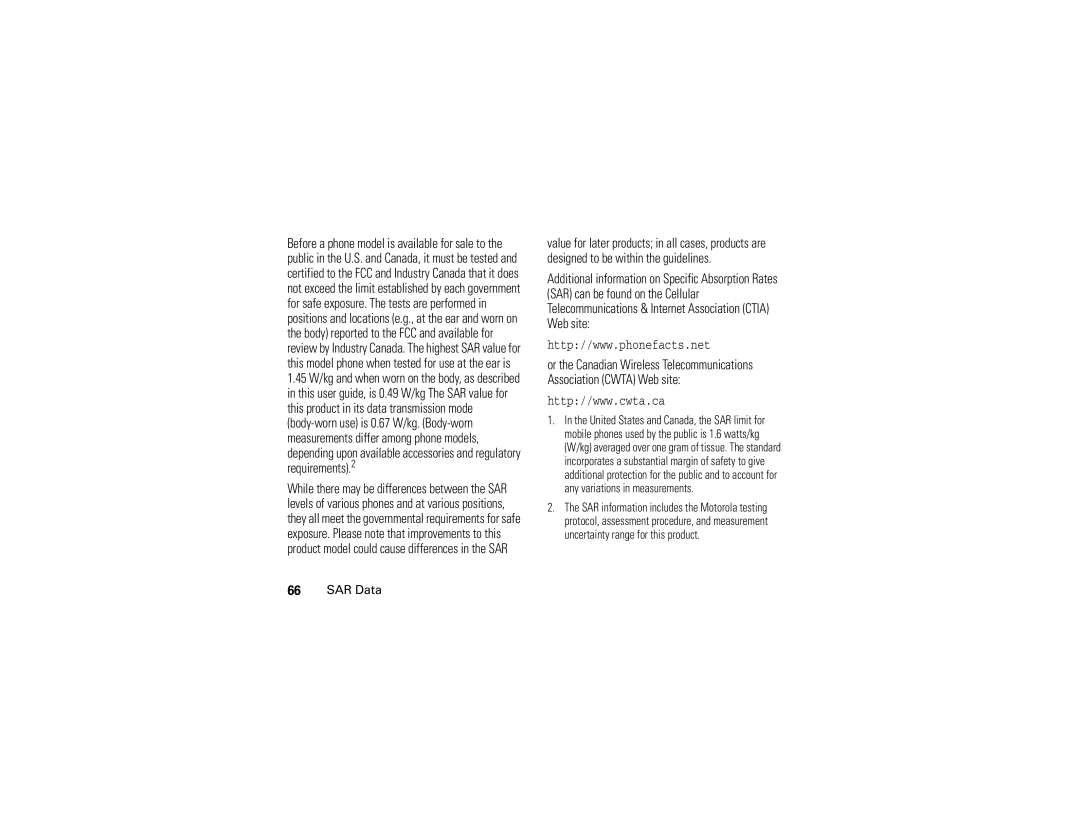V235
Page
Hellomoto
Motorola, Inc Manual Number 6809499A63-O
Contents
Hearing Aid
Optional features
Menu map
Main menu
Menu map
Settings menu
Initial Setup Network
Cleaning solutions
Liquids of any kind
Extreme heat or cold
Microwaves
About this guide
Symbols
Essentials
Battery
Battery installation
To install a SIM card To remove a SIM card
SIM card
New batteries are
Battery charging
Battery tips
Turn it on & off
Make a call
Answer a call
Your phone number
From the home screen, press M#to see your number
Main attractions
Take & send a photo
Send a stored photo in a message
Press M Insert Picture
Option
Go To Pictures View stored pictures Photos
Record video
Cable connections
See page 1 for a basic phone diagram
Basics
Display
Basics
CSD call
Status indicators can display at the top of the home screen
Data Indicator Indicators can
Ring Style Indicator Shows the ring style setting
= text message t = voice message
Games & Apps Web Access Multimedia Voice Records Settings
Menu features
Menus
Messages Phonebook Recent Calls Tools
Some features let you enter text
Text entry
ITAP mode
Entry mode
Repeatedly to cycle through the letters
Tap mode
For example, if you press 7764, your phone displays
For example, if you press 81 time, your phone displays
Symbol mode
Volume
Numeric mode
Handsfree speaker
Navigation key
External display
Codes & passwords
Battery meter
Find it Press M w Settings Security New Passwords
Press M wSettings Security Phone Lock
Find it Press M w Settings Phone Status Battery Meter
Change alerts in a ring style
Customize
Ring style
Screen saver
Time & date
Wallpaper
Find it Press M w Settings Personalize Screen Saver
Java Settings App Backlight
Press M w Settings Initial Setup Display Timeout
Display appearance
Find it Press M w Settings In-Call Setup Answer Options
Calls
Turn off a call alert
Recent calls
Find it Press M s Recent Calls
Redial
Settings Auto Redial On or Off
Automatic redial
Return a call
Find it Press M s Recent Calls Notepad
Caller ID
Hold or mute a call
Call waiting
Touch dial
Emergency calls
International calls
To check voicemail messages
Voicemail
Find it Press M e Messages Voicemail
Other features
Advanced calling
Transfer, dial
Attach Number
Quick Dial
Settings Security Call Barring
Settings Phone Status Active Line
Settings Security Fixed Dial
ÉTools Dialing Services Fixed Dial
Feature
Send Tones
Feature Add new
Feature Dial
Phonebook
Email Address
Feature Set ringer
Phonebook entry
Edit Ringer ID
ID for entry
Edit Picture
Or Primary Contacts
Edit Category
Categories
Setup Sort by
New Mailing List
Capacity
Phonebook Setup Search Method Jump to or Find
Copy Entries To
Messages
Messages Browser Msgs
Displays New Message
Message Inbox
Messages Info Services
Cleanup Messages
Inbox Setup
Fax Msg Setup
Personalizing
Voice shortcuts
Other personalizing features
Settings Initial Setup Scroll
Select Name change Select Voice Record
Language
Settings Ring Styles Style Detail Reminders
Settings Personalize Main Menu View
Settings Personalize Main Menu Reorder
Settings Personalize Home Screen Home Keys Icons
Settings Personalize Home Screen Home Keys
Settings Initial Setup Master Reset
Settings Initial Setup Master Clear
Other features-call times & costs
Call times Display call timers
Call times & costs
Handsfree
Data & fax calls
Sync
Settings Network
Set alarm M É Tools Alarm Clock
Network
Personal organizer
Send
Security
Settings Security Certificate Mgmt
Fun & games
Multimedia Pictures
For basic information on the camera, see
Multimedia Sounds New iMelody
New Playlist
Apply as Ringtone
Browser
Web Access Web Sessions
Download key
ÁGames & Apps
Select key
Settings Java Settings App Vibration or App Volume
Effects applications
Service and repairs
Service and repairs
Specific Absorption Rate Data
SAR Data
SAR Data
Important Safety and Legal Information
Software Copyright Notice
Manual Number 6809497A59-O
Safety Information
External Antenna Care
Centimeters 1 inch from your body Safety Information
Product Operation
Follow Instructions to Avoid Interference Problems
Pacemakers
Hearing Aids
Other Medical Devices
Do not place a mobile device in the air bag deployment area
Automobile Air Bags
Potentially Explosive Atmospheres
Symbol Definition
Important safety information follows
Damaged Products
Batteries and Chargers
Glass Parts
Motorola Limited Warranty for the United States and Canada
Warranty
Products and Accessories
Altered Products. Products or Accessories with
Exclusions
Software
Products Covered Length Coverage
Ninety 90 days
Software not Embodied in Physical Media
Phones
Pagers
Devices
Canada All Products
Warranty
Hearing Aid Compatibility with Mobile Phones
Hearing Aid Compatibility
Hearing Aid Compatibility
Online Product Registration
WHO Information
Thank you for choosing a Motorola product
Export Law Assurances
Wireless The New Recyclable
Smart Practices While Driving
Drive Safe, Call Smart SM
Smart Practices While Driving
Sleet, snow, ice, and even heavy traffic can be hazardous
Case of fire, traffic accident, or medical emergencies
Index
Dialed calls 33 display 17
Number. See phone number numeric entry mode
Tap text entry mode 23 telephone number. See
Page
